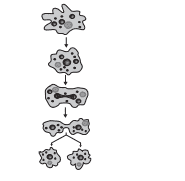1. Clones are
a) Morphologically similar
b) Genetically similar
c) Both (a) and (b)
d) None of these
Explanation: Both (a) and (b)
2. The approximate life span of a parrot is
a) 60 years
b) 1–2 weeks
c) 15 years
d) 140 years
Explanation: 140 years
3.The approximate life span of a crocodile is
a) 60 years
b) 15 years
c) 150 years
d) 140 years
Explanation: 60 years
4. Arrange the following in decreasing order of their life span.
(1) Crocodile
(2) Dog
(3) Crow
(4) Parrot
a) 1 > 2 > 3 > 4
b) 2 > 3 > 4 > 1
c) 4 > 1 > 2 > 3
d) 4 > 1 > 3 > 2
Explanation: 4 > 1 > 2 > 3
5. Life span of a tortoise is approximately
a) 50–100 years
b) 100–150 years
c) 150–200 years
d) 200–250 years
Explanation: Life span of a tortoise is approximately 100–150 years.
6. The given diagram shows:

a) Budding in bacteria
b) Binary fi ssion in amoeba
c) Budding in yeast
d) Budding in sponge
Explanation: Budding in yeast
7. Sexual reproduction is characterized by
a) Two parent participation
b) Formation of gametes
c) Fusion of gametes
d) All of these
Explanation: All of these
8. Asexual reproduction is common among all except
a) Unicellular organisms
b) Plants with simple organization
c) Animals with simple organization
d) Animals with complex organization
Explanation: Animals with complex organization
9. Name an organism where cell division is itself a mode of reproduction?
a) Amoeba
b) E. coli
c) Euglena
d) All of these
Explanation: All of these
10. The given diagram shows

a) Budding in bacteria
b) Binary fission in amoeba
c) Budding in yeast
d) Budding in sponge
Explanation: Binary fission in amoeba